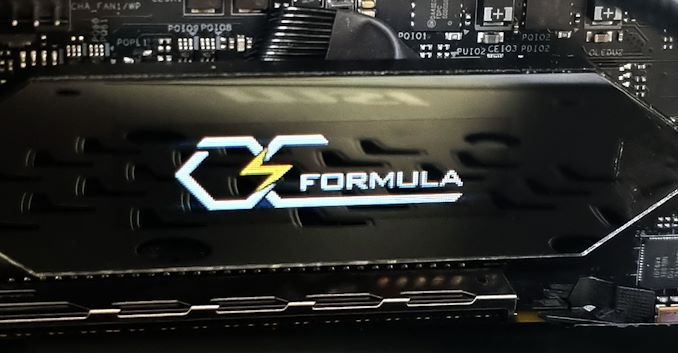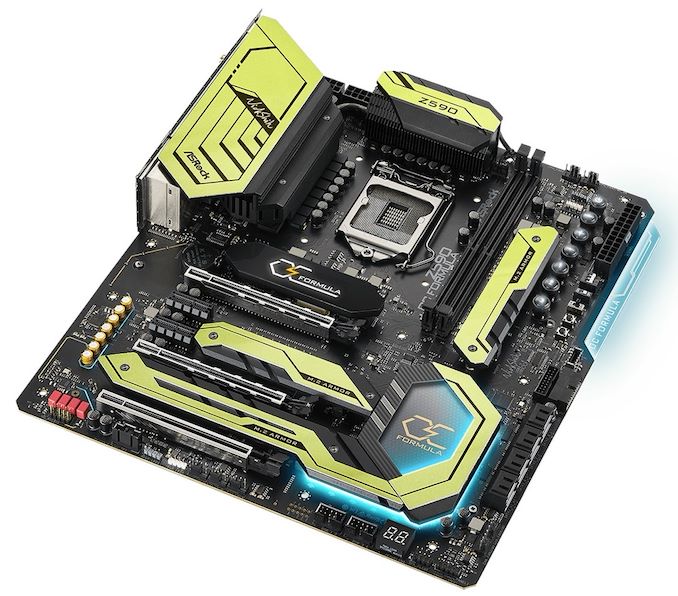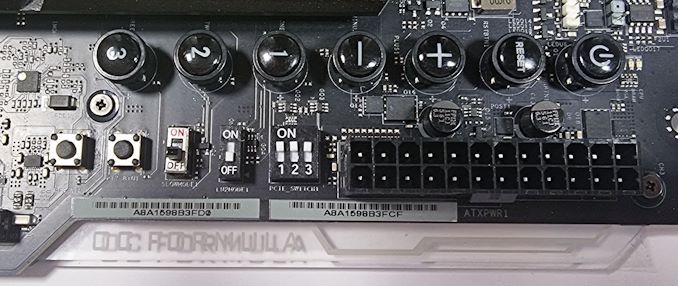The ASRock Z590 OC Formula Review: An Iconic Brand Revival
by Gavin Bonshor on September 10, 2021 9:00 AM EST
Whether overclocking the CPU is your cup of morning tea/coffee/something stronger or not, there are specific motherboards built by professional overclockers and engineers designed to squeeze out as much performance as possible. For example, while the regular everyday PC user might groan at the thought of spending $500 on a Z590 motherboard with two memory slots, boards such as the ASRock Z590 OC Formula pay homage to the art of overclocking. As such, legendary overclocker and ASRock employee Nick Shih has overseen the design and creation of one of the best series of motherboards for overclocking. The OC Formula has been ASRock's brand for their pinnicle performance motherboards for generations - it seemed dead as we hand't seen it in a while, but it as come back with some blazing style. The latest iteration has had a facelift and comes with a wave of features - but can ASRock strike the right balance between enthusiast and conventional? Let's find out in our review of the Z590 OC Formula.
That @ASRockInfo OC Formula life pic.twitter.com/GCSG1KAjgP
— 𝐷𝑟. 𝐼𝑎𝑛 𝐶𝑢𝑡𝑟𝑒𝑠𝑠 (@IanCutress) February 10, 2020
ASRock: Does it have the Right Formula?
ASRock first launched its Z87 OC Formula in 2013, and it recieved rave reviews at a time when overclocking was an exciting pasttime in the industry,. This was followed up with Z97, Z170, X99, and X299 versions - the last one in 2017. Then the brand went to sleep. We cried out for a reboot on twiiter, to no response at the time. But Nick was waiting in the wings.
Nick Shih, ASRock's in-house overclocker, has overseen the design of them all. There are official overclocking ranking leagues, and he has sat on the top. If there were to ever be an extreme Overclockers Hall of Fame, you would find Nick listed among the other historic legends: hipro, rsannino, rbuass, andreyang, Splave, 8pack, Dancop, Hicookie, k|ngp|n, Fredyama, der8auer, Shamino, Smoke, Toppc and others - for those that have lived in the overclocking leages over the last two decades, these were the trailblazers, and a number of them were picked up by motherboard manufacturers to make better products.
That's why, every so often, we get a focused overclocking motherboard to push the limits. That what the OC Formula is here to do, while also offering a stable base for a system build. For the OC Formula, the last 'mainstream' model was the very popular Z170M, a model Ian actually turned down for review at the time because our motherboard coverage was skewing ASRock for the year and we wanted to balance it out. It is perhaps one of the most desirable boards for sub-zero and breaking world records there has been since the launch of Intel's Skylake back in 2015. Even I have been scouting for one for my personal collection to no avail.
With all that in mind, when ASRock announced the Z590 OC Formula was coming to market and offered us a sample, it was important to put all of that to the back of my mind and approach the board with a neutral perspective. If there's been one constant in all our OC Formula reviews, it's that balance between being suitable for a more common market and its overclocking potential - a system fully pivoted to overclocking would not be a good consumer product. The state of overclocking has changed since ASRock's last OCF launch, and one of the reasons we published a test on the limits of daily system user-overclockability across multiple 11900K chips and mulitple Z590 boards before we got to the OC Formula.
While the previous generations of OC Formula's have had an iconic vibrant yellow and black theme, the latest ASRock Z590 OC Formula opts for a flashier metallic yellow (almost gold) with lots of integrated RGB LED lighting for users to create a custom look. Conventional PC users looking to build a system around the ASRock Z590 OC Formula will find a formidable yet premium desktop-based feature set.
For an overclocking-focused model, it does include a lot of what the 'regular' Z590 motherboards include, such as three M.2 slots, including one with support for the fastest available PCIe 4.0 x4 NVMe drives. Other storage options include eight SATA ports, with six of them supporting the regular Intel-based RAID arrays. Networking includes a typical premium 2.5 GbE port, a Gigabit port, and Intel's latest Wi-Fi 6E CNVi for users planning on connecting to the internet wirelessly. Other features include a fairly premium HD audio codec and DAC pairing, which takes care of the integrated audio and plenty of USB options on the rear panel. Despite there being no USB 3.2 G2x2 Type-C on the rear panel, there is a regular 10 Gbps Type-C port there, but users wanting 20 Gbps can use a front panel header to achieve this if the chassis used supports this as it is a premium feature of Z590.
Perhaps the biggest feature set akin to the ASRock Z590 OC Formula is within the strong overclocking feature set, which coincides with the pedigree given by the other OC Formula boards in the past. This is also ever-present in the memory department, as the Z590 OC Formula, according to ASRock, supports up to DDR4-6000 in its specifications. This is done over two memory slots, which will also help those competing in the leagues to dial in some quick memory timings without interference of 2 memory slots per channel. Despite the larger than usual E-ATX size, the PCB is an intentional ploy by ASRock to improve memory performance when using extreme cooling methods such as liquid nitrogen or dry ice. Other overclocking-focused elements on the OC Formula include a robust and plentiful overclockers toolkit and a dedicated LN2 mode dip switch that users can enable or disable depending on the cooling type used.
Performance Overview
Looking at performance, the Z590 OC Formula performed respectably in our stock performance test suite, including compute, gaming, and our system-focused tests. We saw a higher power draw in both long idle and idle power states than other Z590 models tested, but the OC Formula did well at full-load. The ASRock breezed through our non-UEFI POST time testing and DPC latency with solid results in both of these tests. Sometimes an overclocking focused motherboard rejects having a good baseline performance mode, but the OC Formula ticks the box that means that even without tweaking, it can work for everyone.
With overclocking being the thing that is meant to set the OC Formula apart from 'regular' Z590 models, we saw very tight VDroop control throughout all of our testing. We even managed to hit 5.3 GHz all-core stable with our Core i9-11900K, which only a small handful of models have achieved so far, although we were hit by thermals rather than board limits. We also saw good thermal efficiency in our VRM thermal testing, with the OC Formula sitting as one of the best boards we've tested so far. This is down to the active cooling design of the power delivery heatsink and a premium 16-phase design that you would expect from a model of this caliber.

The ASRock Z590 OC Formula undergoing our VRM thermal testing
When it comes down to looking for a motherboard specifically designed to maximize the performance and impact with Intel's Rocket Lake processors, there are 55+ models to choose from. Only four of those are overclocking focused like the OC Formula. Looking at the price, the ASRock Z590 OC Formula is one of the cheapest with an MSRP of $550, with GIGABYTE's Z590 Aorus Tachyon, which has a similar feature set, at the slightly cheaper MSPR of $530. Other models include the ASUS ROG Maximus XIII Apex at $600, while the dark horse of the bunch is the EVGA Z590 Dark (review coming soon), which is available directly from its website for $600. All four of these models have comparative features, two memory slots for improved memory performance, as well as 2.5 GbE, Wi-Fi 6E, and plenty of M.2 slots to cater to regular users.
When it comes to buying an overclocking-focused motherboard, many of the current extreme overclockers in the world will have a general idea of the brand it will go with (it also depends if they are sponsored or not), as well as trawling through the large HWBOT database to determine how each is performing against each other in terms of world records, benchmark performance, and overclockers achieved. Today we will be focusing purely on performance with our motherboard test bench. Although we will be reviewing the EVGA Z590 Dark in the coming weeks, we've already reviewed the GIGABYTE Z590 Aorus Tachyon, so now it's time to see how the OC Formula stacks up against other Z590 models we've tested.
Read on for our extended analysis.












20 Comments
View All Comments
Kracken'm all - Friday, September 10, 2021 - link
Frankly overpriced and useless if we are being scalped hard for higher end cpu and gpu.Actually mobo manufacturers should pay us on top using their board as nvidia and amd are fucking everything up so bad but just don't give a crap but fakers for money.
prophet001 - Friday, September 10, 2021 - link
HPCs are like fishing lures... they're not made to catch fish they're made to catch fishermen.I feel embarrassed thinking about some of the stuff I bought and bought into when I was younger.
Wrs - Friday, September 10, 2021 - link
Why would you blame or take out your anger on a mobo maker for a shortage of cpus/gpus caused by a biological virus?!The mobo is a beast and seems priced at a slight *discount* to the market. Let's hope it's dependable because I don't know about that warranty... probably explains the discount.
For those that don't appreciate on-board power buttons and resets/switches and metal backplates because its all covered by a computer case, get a cheaper board, this one isn't for you. It's a niche product painfully torn between mass-market usability and catering to a small community of hardcore overclockers. Because it includes features for two mutually exclusive audiences, it's always going to be at least somewhat overpriced to either group.
The only complaint I'd have is the placement of that on-board OLED display. It's likely to be obscured by insulation or high end air cooling. Probably should get rid of it, buff up the diagnostic display to a full time monitoring display.
TheinsanegamerN - Monday, September 13, 2021 - link
"Why would you blame or take out your anger on a mobo maker for a shortage of cpus/gpus caused by a biological virus?!"Still on that theory? That's cute. There's plenty of GPUs shipping out of china, they just are not coming to us.
" It's a niche product painfully torn between mass-market usability and catering to a small community of hardcore Suckers."
FTFY. All this money and design for another 50 MHz bin over a normal $180 Z series board. The days of hardcore OCingbeing entertaining ar ebehind us when CPUs hit 95% of that performance level on their own now.
Wrs - Monday, September 13, 2021 - link
What? It's generally accepted that Covid is the primary cause of the chip shortage, but far from the only cause. Covid produced quarantines and lockdowns, messed with factory production here and there, made a lotta people scramble for electronics to work from home - there's the impact on both supply and demand. There are some compounding factors like China tariffs, an island off China running out of water (I don't say that with a straight face), car industry cutting orders before a surprise sales boom, and other details I needn't list here.Overclocking is legit, but getting more niche these days - on that you are absolutely right. The mainstream has trended toward what formerly was entry level OC - big beefy ambient coolers. I don't particularly like the inefficient Rocket Lake to start - inefficiency is what necessitates expensive boards, after all - but this article isn't about a board built for mainstream cooling, and 50 MHz is certainly not all you're expected to get over a $180 board... though perhaps it is close to all you'll get using what this site did, an ambient AIO cooler. That's just not right to cool >300w in half a square inch, nor is it any good for reducing thermal and electrical resistivity in silicon. Rocket Lake runs so hot, the minimum you'd need to see real progress is ice water. This board, with all its slow boot switches, is clearly set up for phase change or LN2, and I am not prepared to ask Anandtech to cough up that kind of expertise...
Spunjji - Monday, September 13, 2021 - link
"Frankly overpriced and useless"Yes
*everything else you wrote*
No
svan1971 - Friday, September 10, 2021 - link
AsRock before you buy check out their warranty info its a disaster.Slash3 - Friday, September 10, 2021 - link
The first board in the series was the Z77 OC Formula, not the Z87. I've still got mine running in a secondary system. :)Slash3 - Friday, September 10, 2021 - link
One other note, the testbed chart lists an 11900K with pricing of $374, which is clearly incorrect.AllMuscle1 - Friday, September 24, 2021 - link
Same here! I was about to laugh when I saw it clearly displayed in the photograph and yet, he stated Z87. The Z77 for Ivy Bridge was amazing! It's now in my daughter's system.